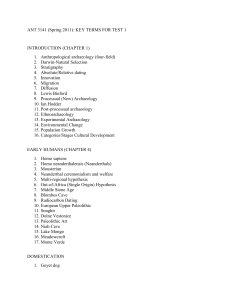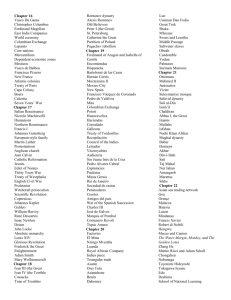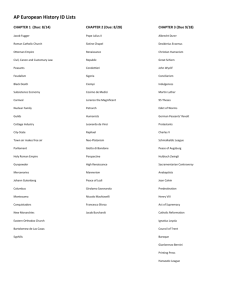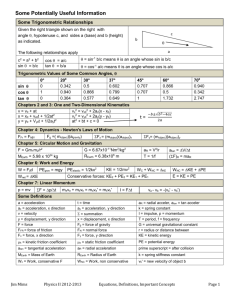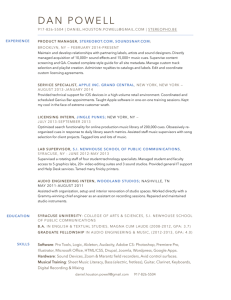IB Music
advertisement
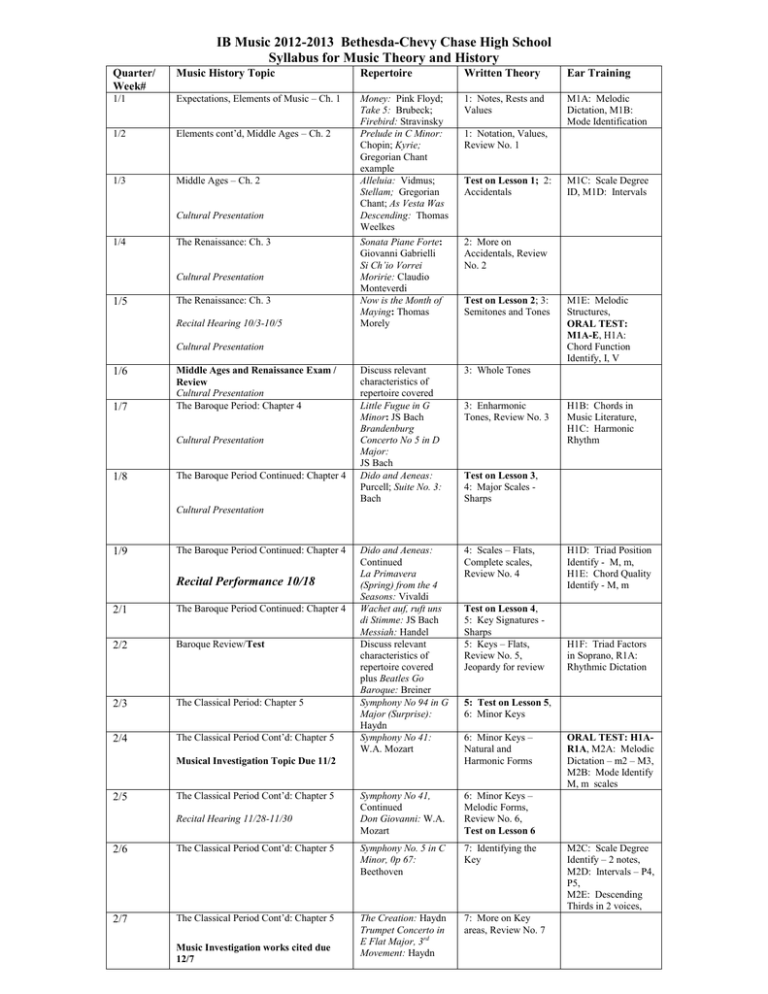
IB Music 2012-2013 Bethesda-Chevy Chase High School Syllabus for Music Theory and History Quarter/ Week# Music History Topic Repertoire Written Theory Ear Training 1/1 Expectations, Elements of Music – Ch. 1 1: Notes, Rests and Values M1A: Melodic Dictation, M1B: Mode Identification 1/2 Elements cont’d, Middle Ages – Ch. 2 1/3 Middle Ages – Ch. 2 Money: Pink Floyd; Take 5: Brubeck; Firebird: Stravinsky Prelude in C Minor: Chopin; Kyrie; Gregorian Chant example Alleluia: Vidmus; Stellam; Gregorian Chant; As Vesta Was Descending: Thomas Weelkes Sonata Piane Forte: Giovanni Gabrielli Si Ch’io Vorrei Moririe: Claudio Monteverdi Now is the Month of Maying: Thomas Morely 2: More on Accidentals, Review No. 2 Discuss relevant characteristics of repertoire covered Little Fugue in G Minor: JS Bach Brandenburg Concerto No 5 in D Major: JS Bach Dido and Aeneas: Purcell; Suite No. 3: Bach 3: Whole Tones Dido and Aeneas: Continued La Primavera (Spring) from the 4 Seasons: Vivaldi Wachet auf, ruft uns di Stimme: JS Bach Messiah: Handel Discuss relevant characteristics of repertoire covered plus Beatles Go Baroque: Breiner Symphony No 94 in G Major (Surprise): Haydn Symphony No 41: W.A. Mozart 4: Scales – Flats, Complete scales, Review No. 4 Symphony No 41, Continued Don Giovanni: W.A. Mozart 6: Minor Keys – Melodic Forms, Review No. 6, Test on Lesson 6 Cultural Presentation 1/4 The Renaissance: Ch. 3 Cultural Presentation 1/5 The Renaissance: Ch. 3 Recital Hearing 10/3-10/5 1: Notation, Values, Review No. 1 Test on Lesson 1; 2: Accidentals Test on Lesson 2; 3: Semitones and Tones Cultural Presentation 1/6 1/7 Middle Ages and Renaissance Exam / Review Cultural Presentation The Baroque Period: Chapter 4 Cultural Presentation 1/8 The Baroque Period Continued: Chapter 4 3: Enharmonic Tones, Review No. 3 M1C: Scale Degree ID, M1D: Intervals M1E: Melodic Structures, ORAL TEST: M1A-E, H1A: Chord Function Identify, I, V H1B: Chords in Music Literature, H1C: Harmonic Rhythm Test on Lesson 3, 4: Major Scales Sharps Cultural Presentation 1/9 The Baroque Period Continued: Chapter 4 Recital Performance 10/18 2/1 The Baroque Period Continued: Chapter 4 2/2 Baroque Review/Test 2/3 The Classical Period: Chapter 5 2/4 The Classical Period Cont’d: Chapter 5 Musical Investigation Topic Due 11/2 2/5 The Classical Period Cont’d: Chapter 5 Recital Hearing 11/28-11/30 Test on Lesson 4, 5: Key Signatures Sharps 5: Keys – Flats, Review No. 5, Jeopardy for review H1F: Triad Factors in Soprano, R1A: Rhythmic Dictation 5: Test on Lesson 5, 6: Minor Keys 6: Minor Keys – Natural and Harmonic Forms 2/6 The Classical Period Cont’d: Chapter 5 Symphony No. 5 in C Minor, 0p 67: Beethoven 7: Identifying the Key 2/7 The Classical Period Cont’d: Chapter 5 The Creation: Haydn Trumpet Concerto in E Flat Major, 3rd Movement: Haydn 7: More on Key areas, Review No. 7 Music Investigation works cited due 12/7 H1D: Triad Position Identify - M, m, H1E: Chord Quality Identify - M, m ORAL TEST: H1AR1A, M2A: Melodic Dictation – m2 – M3, M2B: Mode Identify M, m scales M2C: Scale Degree Identify – 2 notes, M2D: Intervals – P4, P5, M2E: Descending Thirds in 2 voices, 2/8 The Classical Period Cont’d: Chapter 5 Analysis of 1st Piece 12/21 Pathetique Sonata: Beethoven Test on Lesson 7 2/9 Review/Test on Classical Period Discuss characteristics of repertoire covered Erlkonig: Schubert Symphony No. 8: Schubert 8: Intervals – Perfect, Major Hebrides Overture: Mendelssohn, Violin Concerto in E Minor: Mendelssohn Nocturne in E flat: Chopin, Kinderscenen: Schumann 8: Intervals with a key signature, melodic interval Romeo and Juliet: Tchaikovsky, Symphonie Fantastique: Berlioz Sym. No. 4: Brahms, Pictures at an Exhibition: Mussorgsky, Review No. 8 Test on Lesson 8 The Moldau: Smetana, Sym. No. 9 “New World”: Dvorak, La Boheme: Puccini Die Walkure: Wagner, Sym. No. 1: Mahler Discuss characteristics of repertoire covered La Mer: Debussy, Prelude to the Afternoon of a Faun: Debussy, Bolero: Ravel The Rite of Spring: Stravinsky, Classical Sym: Prokofiev Classical Sym: Prokofiev Rhapsody in Blue: Gershwin; Maple Leaf Rag: Joplin, West Side Story: Bernstein El Salon Mexico: Copland Piano Concerto: Xian; Discuss relevant characteristics of repertoire covered Piano Concerto: Xian African Sanctus: Fanshaw, Elephant Hunting Song: Mbuti Pygmies, Kek-Kack: Indonesian Tribal Review key factors from all musical periods 9: Triads – minor, dominant Recital Performance 1/3 3/1 Romantic Period: Chapter 6 3/2 Romantic Period cont’d: Chapter 6 Recital Hearing-1/30-2/1 3/3 Romantic Period cont’d: Chapter 6 Analysis of 2nd piece 2/8 3/4 Romantic Period cont’d: Chapter 6 3/5 Romantic Period cont’d: Chapter 6 Recital Performance 2/21 3/6 Romantic Period cont’d: Chapter 6 Music Investigation Rough Draft 3/4 3/7 Romantic Period cont’d: Chapter 6 3/8 Review/Test on Romantic Period Recital Hearing 3/6-3/8 3/9 Twentieth Century and Beyond: Ch. 7 4/1 Twentieth Century and Beyond: Ch. 7 Recital Performance 3/21 4/2 Twentieth Century and Beyond: Ch. 7 Music Investigation – Final Project Deadline 3/22 4/3 Twentieth Century and Beyond: Ch. 7 4/4 Review/Test on Twentieth Century and Beyond 4/5 World Music 4/6 Mock Test of IB Exam 8: Intervals – Perfect, Major, and Minor 8: Harmonic interval 9: Triads - Major 9: Triads Subdominant ORAL TEST: M2A-E, H2A: Chord Function Identification I, IV, V, H2B: Chords in Music Literature – I, IV, V H2C: Non-Harm Tones, H2D: Triad Pos. ID H2E: Ch. Qty ID M, m, dim H2F: Triad Factors in Soprano, R2A: Rhythmic Dictation – Duple & Triple subdivision, ORAL TEST: H2A – R2A M3A: Melodic Dictation – m2 – P5, M3B: Error Detection, M3C: Scale Degree Identify – 3 notes M3D: Intervals – m2 – P5, M3E: Mel. Str., Rev. M3A-E 9: Review No. 9 Test on Lesson 9 ORAL TEST M3A-E Lesson 13 - Analysis Lesson 13 – Analysis, Sequence 20th Century Music scales 20th Cent. Music – blues and octatonic scales H3A: Chord Function Identify – I, ii, V H3B: Chords in Music Literature Review of 20th Century Scales H3C: Cadence Identification Test on 20th Century Scales ORAL TEST: H3A – H3C
